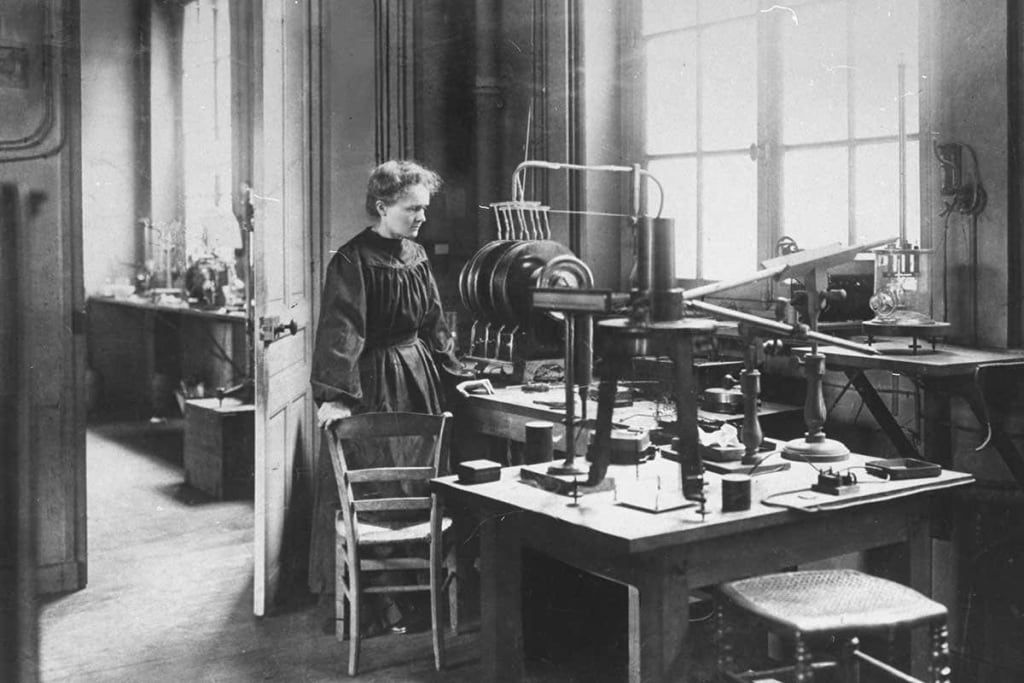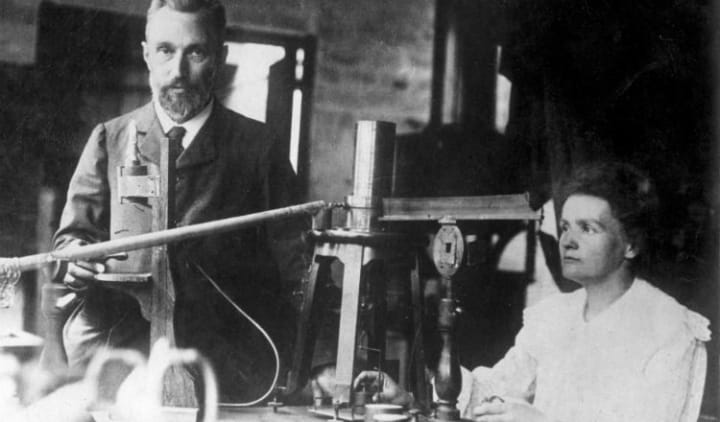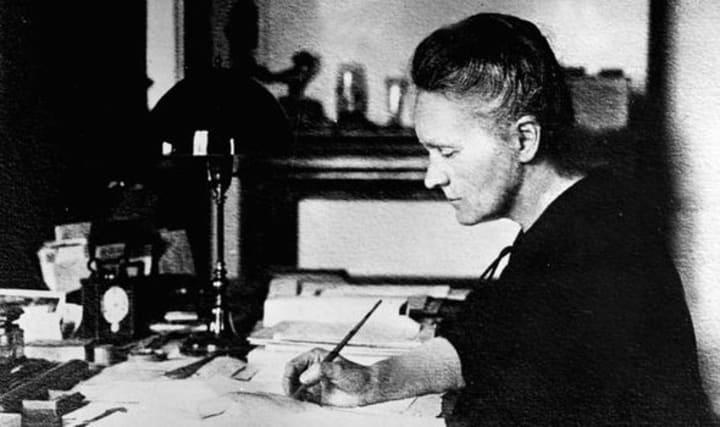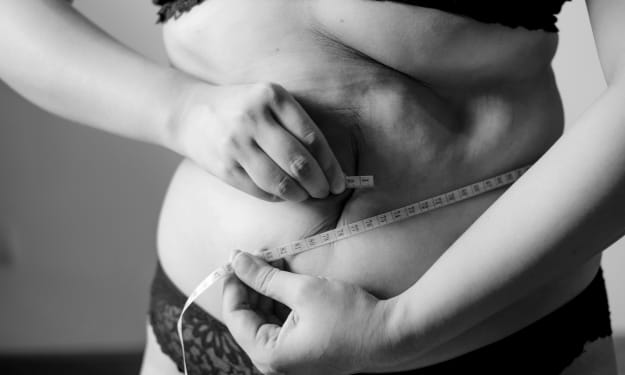Marie Curie
"We must have perseverance and above all confidence in ourselves"

“We must believe that we are gifted for something and that this thing must be attained.” We all know the name but --- is that all? The first woman to be given a Nobel Prize and the first person to win 2 Nobel Prizes, this woman ‘blazed’ the trail where cancer research is concerned. Who was Marie Curie?
Born in Warsaw, Poland, on 7th November, 1876, Maria Sklodowska was the youngest of 5 children and her parents were poor school teachers. Marie’s mother died of tuberculosis in 1878, and her oldest sibling died of typhus 3 years earlier. This led to Maria’s loss of faith and she gave up Catholicism and became agnostic. At 10 years of age, this young woman attended a boarding school and a gymnasium for girls, where she graduated with a gold medal. After collapsing (possibly because of depression), Maria spent a year in the countryside with relatives, and then joined her father in Warsaw, where she did some tutoring.
Reading and studying in her own time, Maria had a real thirst for knowledge and also became a governess. As there were not enough finances, Maria could not go onto further education. However, hse sister offered Maria lodgings in Paris “with a view to going to university” and Maria grasped this opportunity with both hands and moved to France in 1981. Maria entered the Sorbonne University in Paris where she read physics and mathematics, subjects she loved. Maria existed on ‘meagre resources’, keeping herself warm during the winters by wearing all of her clothes, and being so focused on her studies that she forgot to eat. Maria would study during the day and tutor in the evenings, barely earning her keep. (This must sound so familiar to any students reading this!) Maria was rewarded for her hard work in 1893, when she received a degree in physics and could now start working in an industrial laboratory of Gabriel Lippmann. Still thirsty for knowledge, Maria continued her studies at the University of Paris and (with the aid of a fellowship) was able to earn a second degree in 1894.
In this same year, Maria met Pierre Curie and their mutual love for the natural sciences drew them together. Pierre was an instructor at The City of Paris Industrial Physics and Chemistry Higher Education Institution (ESPCI Paris), and was able to find space in his laboratory for Maria to start her work. Pierre proposed marriage to Maria but she wanted to return to her native country, which she did. However, Maria was denied a place at Krakow University because she was a woman. Pierre wrote to Maria and convinced her to return to Paris, where she pursued a Ph.D. Pierre wrote up his research on magnetism and received his own doctorate in March, 1895, (after Maria’s encouragement). Pierre was now promoted to Professor at the School.

The young couple married on 26th July, 1895, in Sceaux and neither wanted a religious ceremony. The newly-married couple shared long bicycle trips and journeys abroad, and this brought them closer together. “In Pierre, Maria had found a new love, a partner and a scientific collaborator on whom she could depend.” It was at this time that Maria adopted the French spelling of her name --- Marie.
The Curies became research workers at the School of Chemistry and Physics in Paris, and it was here that they began their “work.” Marie used the “electrometer” to investigate samples. The “electrometer” is a sensitive device for measuring electric charge. She discovered that uranium rays caused the air around a sample to conduct electricity. Marie hypothesized that the radiation was not the outcome of some interaction of molecules but must come from the atom itself. The Curies used a converted shed as a laboratory but were unaware of the effects of radiation exposure, as the shed was poorly ventilated and not waterproof as well as the Curies being ‘unprotected.’
In 1897, Maria gave birth to their daughter Irene, and to help support the family finances, she began teaching at the Ecole Normale Superieure. In the meantime, Marie continued her research on ‘radiation.’ The work was heavy and demanding for both Pierre and Marie, who were now beginning to feel sick and physically exhausted. Today, we know this to be the ill-effects of radiation poisoning, but back then it was still unknown. They persevered (in their ‘ignorance’) often with raw and inflamed hands “because they were continually handling highly radioactive material.”
In 1902, Marie eventually isolated radium (as radium chloride). Pierre and Marie were awarded the Nobel Prize for Physics for their work on radioactivity in 1903. In this same year, Marie passed her doctorate thesis in Physics.
In 1906, their second daughter, Eve, was born and Marie hired a Polish governess to teach their daughters the Polish language (Marie’s native language). Tragedy struck when, in 1906, Pierre was killed in a street accident, having been knocked down by a horse and cart. Marie was heartbroken but carried on with ‘their work’ and went on to succeed her late husband in his Chair as Professor at the Sorbonne (the first woman to do so). Marie also followed on lecturing where Pierre had left off. Her determination and “remarkable endeavours” were rewarded when Marie received a second Nobel Prize in 1911, in Chemistry for creating a means of measuring radioactivity. The first radium institute was built (by Sorbonne) with 2 laboratories; one for the study of radioactivity (under the direction of Marie) and one for biological research into the treatment of cancer.

World War 1 started and Marie realized that wounded soldiers were best served if operated on sooner rather than later. She saw the need for field radiological centres to be near the front lines and this would assist the battlefield surgeons. Marie managed to get x-ray equipment, vehicles, auxiliary generators, and develop mobile radiography units (and these came to be known as “petites Curies” or “little Curries.” Marie became the director of the Red Cross Radiology Service and set up France’s first military radiology centre, which was operational by late 1914. With the help of a military doctor and her daughter, Irene, Marie directed the installation of 20 mobile radiological vehicles and another 200 radiological units at field hospitals --- all of this within the first year of the War. Later on, Marie started to train other women as “aides.” Over a million wounded soldiers were treated with these x-ray units.
When World War 1 finally came to an end, Marie put her wartime experiences in a book --- “Radiology in War” (1919). In 1922, Marie became a fellow of the French Academy of Medicine and travelled to other countries, appearing publicly and giving lectures in Belgium, Brazil, Spain and Czechoslovakia. In the same year, Marie Curie became a member of the League of Nations’ newly created International Committee on Intellectual Cooperation. He sat on the committee until 1934. In 1931, Marie was awarded the Cameron Prize for Therapeutics of the University of Edinburgh.
Marie went home to Poland in 1934 and died at the Sancellemoz sanatorium in Passy. She died from ‘aplastic anemia’ believed to have been contracted from her long-term exposure to radiation.

Through Marie Curie’s research, thousands of lives have been saved and we all know the care and support given through “The Marie Curie Foundation.” This woman’s love for her fellow man / woman drove her forwards and we can all be thankful to Marie and “Inspired” by her love for life.
(My research comes from Wikipedia and the Marie Curie website)
If you are interested in reading about other "Women in History", have a look at https://sarah-s-story-book.webnode.co.uk/women-in-history/ and be "Inspired."
About the Creator
Ruth Elizabeth Stiff
I love all things Earthy and Self-Help
History is one of my favourite subjects and I love to write short fiction
Research is so interesting for me too
Enjoyed the story? Support the Creator.
Subscribe for free to receive all their stories in your feed. You could also pledge your support or give them a one-off tip, letting them know you appreciate their work.






Comments
There are no comments for this story
Be the first to respond and start the conversation.